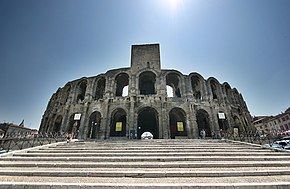Arles Amphitheatre

Arles amphitheater from the north, with one of the three medieval towers.
|
|
| Location | Arles, Bouches-du-Rhône, France |
|---|---|
| Type | Roman amphitheatre |
| Length | 136 m (446 ft) |
| Width | 109 m (358 ft) |
| Height | 21 m (69 ft) |
| History | |
| Founded | 90 AD |
| Periods | Roman Empire |
The Arles Amphitheatre (French: Arènes d'Arles) is a Roman amphitheatre in the southern French town of Arles. This two-tiered Roman amphitheatre is probably the most prominent tourist attraction in the city of Arles, which thrived in Roman times. The pronounced towers jutting out from the top are medieval add-ons.
Built in 90 AD, the amphitheatre was capable of seating over 20,000 spectators, and was built to provide entertainment in the form of chariot races and bloody hand-to-hand battles. Today, it draws large crowds for bullfighting during the Feria d'Arles as well as plays and concerts in summer.
The building measures 136 m (446 ft) in length and 109 m (358 ft) wide, and features 120 arches. It has an oval arena surrounded by terraces, arcades on two levels (60 in all), bleachers, a system of galleries, drainage system in many corridors of access and staircases for a quick exit from the crowd. It was obviously inspired by the Colosseum in Rome (in 72-80), being built slightly later (in 90). The amphitheatre was not expected to receive 25,000 spectators, the architect was therefore forced to reduce the size and replace the dual system of galleries outside the Colosseum by a single annular gallery. This difference is explained by the conformation of the land. This "temple" of the games housed gladiators and hunting scenes for more than four centuries.
With the fall of the Empire in the 5th century, the amphitheatre became a shelter for the population and was transformed into a fortress with four towers (the southern tower is not restored). The structure encircled more than 200 houses, becoming a real town, with its public square built in the centre of the arena and two chapels, one in the centre of the building, and another one at the base of the west tower.
...
Wikipedia
